A 3D-Printed Sole Design Bioinspired by Cat Paw Pad and Triply Periodic Minimal Surface for Improving Paratrooper Landing Protection
Abstract
:1. Introduction
2. Specimen Design and Fabrication
2.1. Mimicking Cat Paw Pads
2.2. TPMS Description and Fabrication
3. Experimental Methods
3.1. Quasi-Static Compression Tests
3.2. Drop Hammer Tests
3.3. Drop Landing Tests
4. FE Model
5. Results and Discussion
5.1. Results of Tests and FE Simulations under Quasi-Static Compression Conditions
5.2. Drop Hammer Test Results
5.3. Drop Landing Test Results
6. Conclusions
Supplementary Materials
Author Contributions
Funding
Institutional Review Board Statement
Informed Consent Statement
Data Availability Statement
Conflicts of Interest
References
- Dufek, J.S.; Bates, B.T. The evaluation and prediction of impact forces during landings. Med. Sci. Sports Exerc. 1990, 22, 370–377. [Google Scholar] [CrossRef]
- Lafourcade, P.; Bruneau, O.; Philippe, A.; Bard, A. Le parachutisme militaire Military parachuting. Sci. Sports 2018, 33, 127–135. [Google Scholar] [CrossRef]
- Kasturi, K.; Kwok, P.; Lee, C. Design and evaluation of protective devices for injury prevention during paratrooper landing. In Proceedings of the 18th AIAA Aerodynamic Decelerator Systems Technology Conference & Seminar, Munich, Germany, 23 May 2005. [Google Scholar]
- Aziz, S.; Gan, K.B.; Rambely, A.S.; Gopal, K.; Ariffin, M.S.; Shattar, N. Relationship between angle and peak vertical ground reaction force estimation in parachute landing fall among army parachutists using mathematical modelling. Alexandria Eng. J. 2022, 61, 5413–5426. [Google Scholar] [CrossRef]
- Ball, V.L.; Sutton, J.A.; Hull, A.; Sinnott, B. Traumatic injury patterns associated with static line parachuting. Wildern. Environ. Med. 2014, 25, 89–93. [Google Scholar] [CrossRef]
- Brizuela, G.; Llana, S.; Ferrandis, R.; Garcia-Belenguer, A.C. The influence of basketball shoes with increased ankle support on shock attenuation and performance in running and jumping. J. Sports Sci. 1997, 15, 505–515. [Google Scholar] [CrossRef]
- Kovács, I.; Tihanyi, J.; Devita, P.; Rácz, L.; Barrier, J.; Hortobágyi, T. Foot placement modifies kinematics and kinetics during drop jumping. Med. Sci. Sports Exerc. 1999, 31, 708–716. [Google Scholar] [CrossRef]
- Blackburn, J.T.; Padua, D.A. Influence of trunk flexion on hip and knee joint kinematics during a controlled drop landing. Clin. Biomech. 2008, 23, 313–319. [Google Scholar] [CrossRef]
- Ly, Q.H.; Alaoui, A.; Erlicher, S.; Ba Ly, L. Towards a footwear design tool: Influence of shoe midsole properties and ground stiffness on the impact force during running. J. Biomech. 2010, 43, 310–317. [Google Scholar] [CrossRef]
- Queen, R.M.; Abbey, A.N.; Wiegerinck, J.I.; Yoder, J.C.; Nunley, J.A. Effect of shoe type on plantar pressure: A gender comparison. Gait Posture 2010, 31, 18–22. [Google Scholar] [CrossRef]
- Logan, S.; Hunter, I.; Hopkins, J.T.; Feland, J.B.; Parcell, A.C. Ground reaction force differences between running shoes, racing flats, and distance spikes in runners. J. Sports Sci. Med. 2010, 9, 147–153. [Google Scholar]
- Fu, W.; Fang, Y.; Gu, Y.; Huang, L.; Liu, Y. Shoe cushioning reduces impact and muscle activation during landings from unexpected, but not self-initiated, drops. J. Sci. Med. Sport 2017, 20, 915. [Google Scholar] [CrossRef]
- Malisoux, L.; Delattre, N.; Meyer, C.; Gette, P.; Urhausen, A.; Theisen, D. Effect of shoe cushioning on landing impact forces and spatiotemporal parameters during running: Results from a randomized trial including 800+ recreational runners. Eur. J. Sport Sci. 2021, 21, 985–993. [Google Scholar] [CrossRef]
- Andrea, R.D.; Elena, L.I.M.; Rubén, S.-G.; Ricardo, B.D.B.V.; Daniel, L.-L.; David, R.-S.; María, M.-J.E.; César, C.-L. Effect of the cushioning running shoes in ground contact time of phases of gait. J. Mech. Behav. Biomed. Mater. 2018, 88, 196–200. [Google Scholar]
- Healey, L.A.; Hoogkamer, W. Longitudinal bending stiffness does not affect running economy in Nike Vaporfly Shoes. J. Sport Health Sci. 2022, 11, 285–292. [Google Scholar] [CrossRef]
- Hébert-Losier, K.; Finlayson, S.J.; Driller, M.W.; Dubois, B.; Esculier, J.-F.; Beaven, C.M. Metabolic and performance responses of male runners wearing 3 types of footwear: Nike Vaporfly 4%, Saucony Endorphin racing flats, and their own shoes. J. Sport Health Sci. 2022, 11, 275–284. [Google Scholar] [CrossRef]
- Lam, W.K.; Liu, H.; Wu, G.Q.; Liu, Z.L.; Sun, W. Effect of shoe wearing time and midsole hardness on ground reaction forces, ankle stability and perceived comfort in basketball landing. J. Sports Sci. 2019, 37, 2347–2355. [Google Scholar] [CrossRef]
- Shariatmadari, M.R.; English, R.; Rothwell, G. Effects of temperature on the material characteristics of midsole and insole footwear foams subject to quasi-static compressive and shear force loading. Mater. Des. 2012, 37, 543–559. [Google Scholar] [CrossRef]
- Nin, D.; Lam, G.W.K.; Kong, P. Effect of body mass and midsole hardness on kinetic and perceptual variables during basketball landing manoeuvres. J. Sports Sci. 2015, 34, 756–765. [Google Scholar] [CrossRef]
- Chatzistergos, P.E.; Gatt, A.; Formosa, C.; Farrugia, K.; Chockalingam, N. Optimised cushioning in diabetic footwear can significantly enhance their capacity to reduce plantar pressure. Gait Posture 2020, 79, 244–250. [Google Scholar] [CrossRef]
- Ali, M.; Nazir, A.; Jeng, J.-Y. Mechanical performance of additive manufactured shoe midsole designed using variable-dimension helical springs. Int. J. Adv. Manuf. Technol. 2020, 111, 3273–3292. [Google Scholar] [CrossRef]
- Uddin, K.Z.; Youssef, G.; Trkov, M.; Seyyedhosseinzadeh, H.; Koohbor, B. Gradient optimization of multi-layered density-graded foam laminates for footwear material design. J. Biomech. 2020, 109, 109950. [Google Scholar] [CrossRef] [PubMed]
- Yan, A.F.; Smith, R.M.; Hiller, C.E.; Sinclair, P.J. Impact attenuation properties of jazz shoes alter lower limb joint stiffness during jump landings. J. Sci. Med. Sport 2017, 20, 464–468. [Google Scholar]
- Ramanathan, A.K.; Parish, E.J.; Arnold, G.P.; Drew, T.S.; Wang, W.; Abboud, R.J. The influence of shoe sole’s varying thickness on lower limb muscle activity. Foot Ankle Surg. 2011, 17, 218–223. [Google Scholar] [CrossRef]
- Wu, X.; Pei, B.; Pei, Y.; Wang, W.; Hao, Y.; Zhou, K. How do Cats resist landing injury: Insights into the multi-level buffering mechanism. J. Bionic. Eng. 2020, 17, 600–610. [Google Scholar] [CrossRef]
- Wu, X.; Pei, B.; Pei, Y.; Hao, Y.; Wang, W. Comprehensive biomechanism of impact resistance in the cat’s paw pad. Biomed Res. Int. 2019, 2019, 2183712. [Google Scholar] [CrossRef]
- Zhang, Z.; Yang, J.; Yu, H. Effect of flexible back on energy absorption during landing in cats: A biomechanical investigation. J. Bionic Eng. 2014, 11, 506–516. [Google Scholar] [CrossRef]
- Zhang, Z.; Yu, H.; Yang, J.; Wang, L.; Yang, L. How cat lands: Insights into contribution of the forelimbs and hindlimbs to attenuating impact force. Chin. Sci. Bull. 2014, 59, 3325–3332. [Google Scholar] [CrossRef]
- Wu, X.; Pei, B.; Pei, Y.; Wu, N.; Zhou, K.; Hao, Y.; Wang, W. Contributions of limb joints to energy absorption during landing in cats. Appl. Bionics Biomech. 2019, 2019, 3815612. [Google Scholar] [CrossRef]
- Yu, H.; Zhang, Z.; Liu, H.; Yang, J.; Wang, L.; Yang, L. A new landing impact attenuation seat in manned spacecraft biologically-inspired by felids. Chin. J. Aeronaut. 2015, 28, 434–446. [Google Scholar] [CrossRef]
- Miao, H.; Fu, J.; Qian, Z.; Ren, L.; Lei, R. How does the canine paw pad attenuate ground impacts? A multi-layer cushion system. Biol. Open 2017, 6, 1889–1896. [Google Scholar] [CrossRef]
- Weeger, O.; Boddeti, N.; Yeung, S.K.; Kaijima, S.; Dunn, M.L. Digital design and nonlinear simulation for additive manufacturing of soft lattice structures. Addit. Manuf. 2019, 25, 39–49. [Google Scholar] [CrossRef]
- Jhou, S.-Y.; Hsu, C.-C.; Yeh, J.-C. The dynamic impact response of 3D-printed polymeric sandwich structures with lattice cores: Numerical and experimental investigation. Polymers 2021, 13, 4032. [Google Scholar] [CrossRef] [PubMed]
- Yang, L.; Yan, C.; Han, C.; Chen, P.; Yang, S.; Shi, Y. Mechanical response of a triply periodic minimal surface cellular structures manufactured by selective laser melting. Int. J. Mech. Sci. 2018, 148, 149–157. [Google Scholar] [CrossRef]
- Kapfer, S.C.; Hyde, S.T.; Mecke, K.; Arns, C.H.; Schröder-Turk, G.E. Minimal surface scaffold designs for tissue engineering. Biomaterials 2011, 32, 6875–6882. [Google Scholar] [CrossRef] [PubMed]
- Sreedhar, N.; Thomas, N.; Al-Ketan, O.; Rowshan, R.; Arafat, H.A. 3D printed feed spacers based on triply periodic minimal surfaces for flux enhancement and biofouling mitigation in RO and UF. Desalination 2018, 425, 12–21. [Google Scholar] [CrossRef]
- Prajapati, M.J.; Kumar, A.; Lin, S.-C.; Jeng, J.-Y. Multi-material additive manufacturing with lightweight closed-cell foam-filled lattice structures for enhanced mechanical and functional properties. Addit. Manuf. 2022, 54, 102766. [Google Scholar] [CrossRef]
- Aguirre, T.G.; Fuller, L.; Ingrole, A.; Seek, T.W.; Wheatley, B.B.; Steineman, B.D.; Donahue, T.L.H.; Donahue, S.W. Bioinspired material architectures from bighorn sheep horncore velar bone for impact loading applications. Sci. Rep. 2020, 10, 18916. [Google Scholar] [CrossRef]
- Niu, W.; Wang, Y.; Yao, J.; Zhang, M.; Fan, Y.; Zhao, Q. Consideration of gender differences in ankle stabilizer selection for half-squat parachute landing. Aviat. Space Environ. Med. 2011, 82, 1118–1124. [Google Scholar] [CrossRef]
- Seegmiller, J.G.; Mccaw, S. Ground reaction forces among gymnasts and recreational athletes in drop landings. J. Athl. Train. 2003, 38, 311–314. [Google Scholar]
- Zhang, L.; Stefanie, F.; Stephen, D.; Chang, S.; Wang, M.Y.; Wei, J.; Lu, W.F. Energy absorption characteristics of metallic triply periodic minimal surface sheet structures under compressive loading. Addit. Manuf. 2018, 23, 505–515. [Google Scholar] [CrossRef]
- Yeow, C.H.; Lee, P.V.S.; Goh, J.C.H. Effect of landing height on frontal plane kinematics, kinetics and energy dissipation at lower extremity joints. J. Biomech. 2009, 42, 1967–1973. [Google Scholar] [CrossRef] [PubMed]
- Koyama, K.; Yamauchi, J. Comparison of lower limb kinetics, kinematics and muscle activation during drop jumping under shod and barefoot conditions. J. Biomech. 2018, 69, 47–53. [Google Scholar] [CrossRef]
- Lake, J.P.; Mundy, P.D.; Comfort, P.; McMahon, J.J.; Suchomel, T.J.; Carden, P. Effect of barbell load on vertical jump landing force-time characteristics. J. Strength Cond. Res. 2021, 35, 25–32. [Google Scholar] [CrossRef] [PubMed]
- Decker, M.J.; Torry, M.R.; Wyland, D.J.; Sterett, W.I.; Richard Steadman, J. Gender differences in lower extremity kinematics, kinetics and energy absorption during landing. Clin. Biomech. 2003, 18, 662–669. [Google Scholar] [CrossRef]
- Skinner, N.E.; Zelik, K.E.; Kuo, A.D. Subjective valuation of cushioning in a human drop landing task as quantified by trade-offs in mechanical work. J. Biomech. 2015, 48, 1887–1892. [Google Scholar] [CrossRef]
- Kwok, P.; Kong, W.; Kasturi, K.; Lee, C.; Hamill, J. A biomechanical study on the parachute landing fall. In Proceedings of the AIAA Aerodynamic Decelerator Systems Technology Conference, Monterey, CA, USA, 19–22 May 2003. [Google Scholar]
- Niu, W.; Wang, L.; Jiang, C.; Zhang, M. Effect of dropping height on the forces of lower extremity joints and muscles during landing: A musculoskeletal modeling. J. Healthc. Eng. 2018, 2018, 2632603. [Google Scholar] [CrossRef]
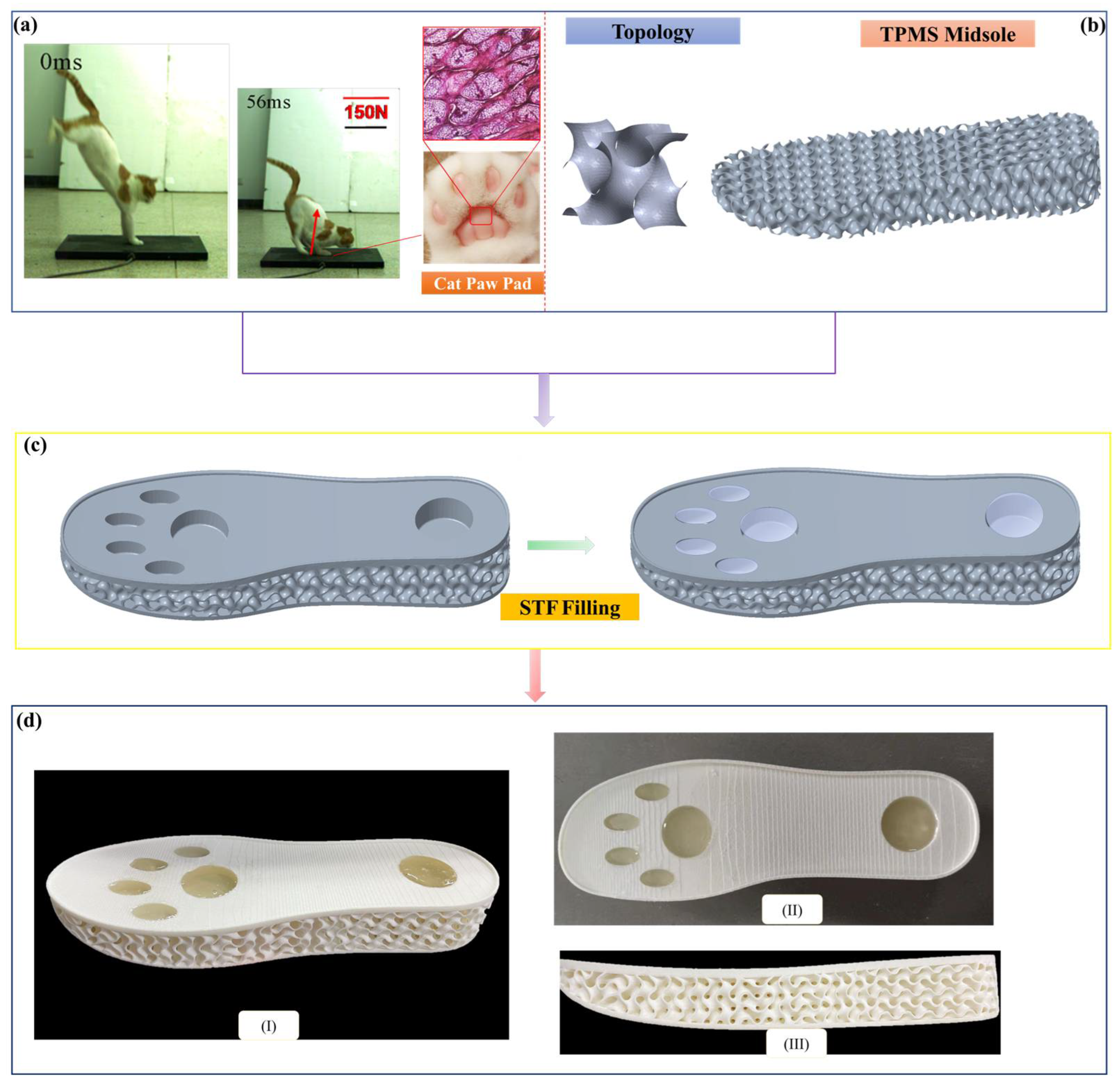
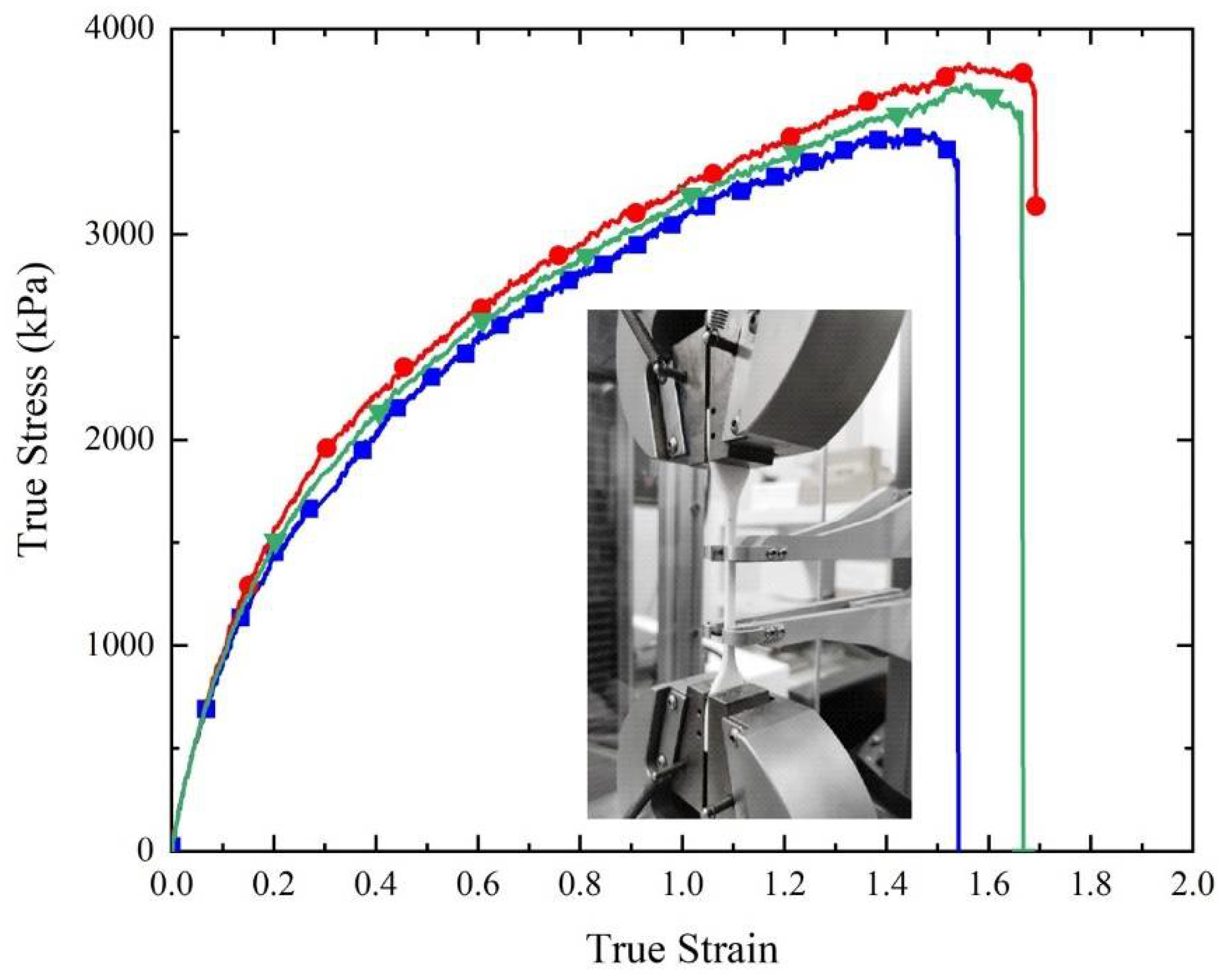

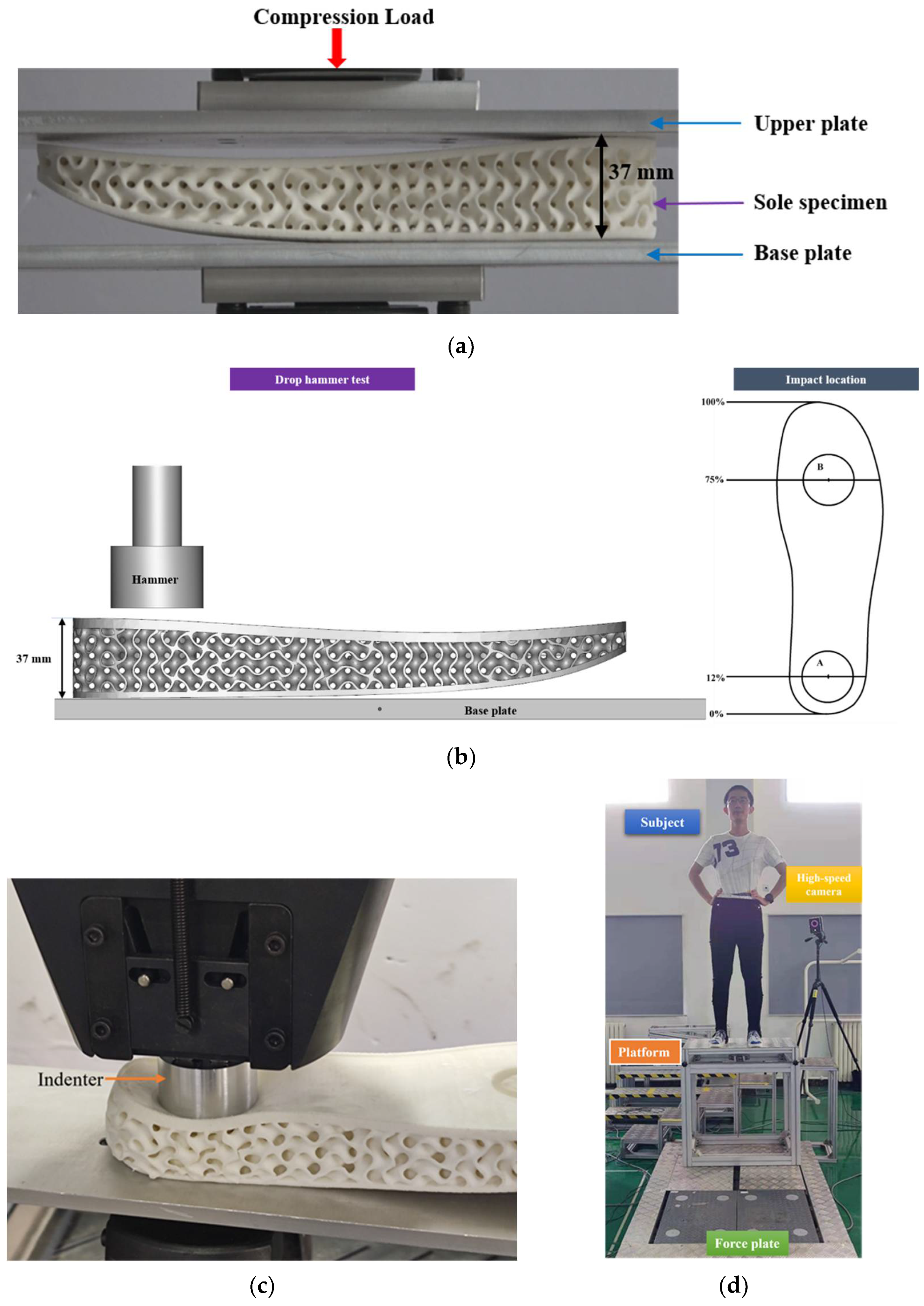


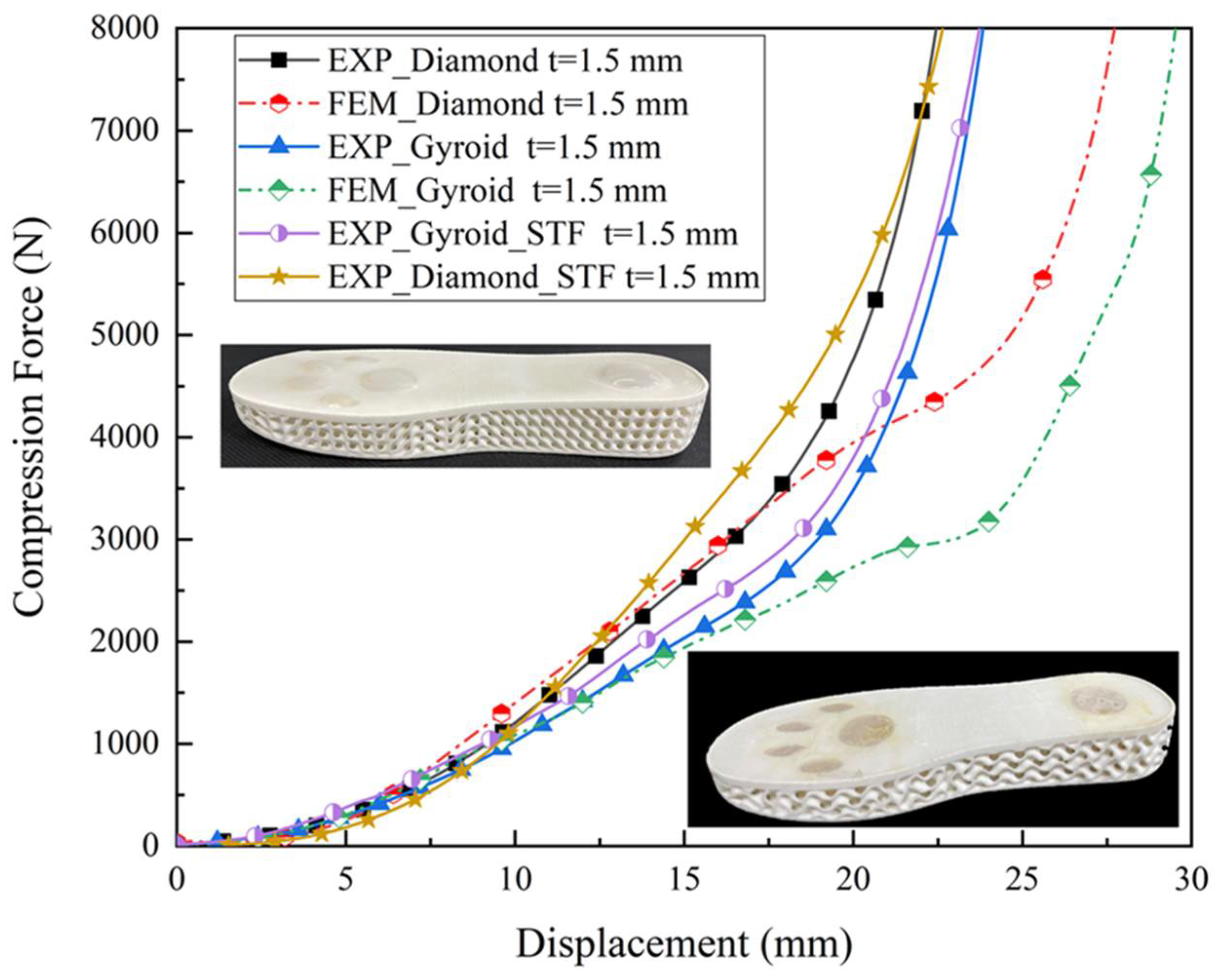
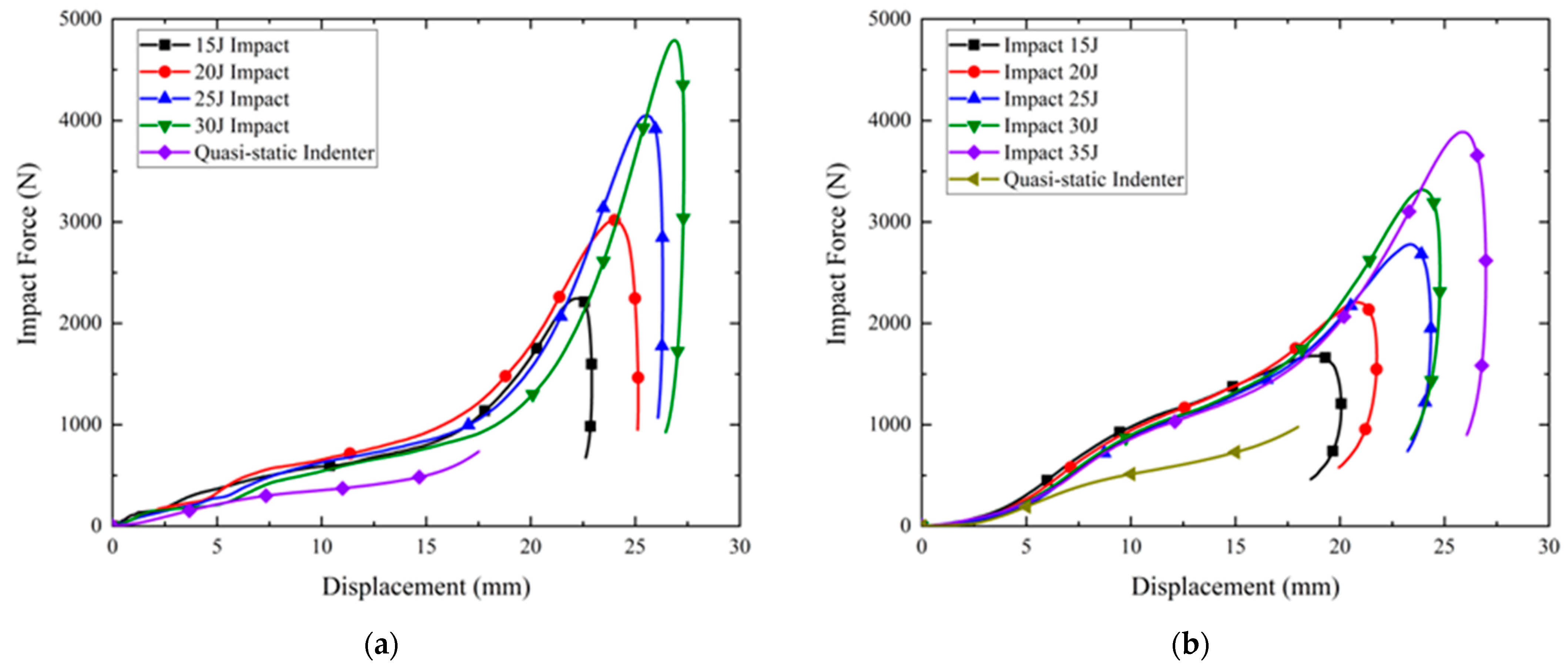
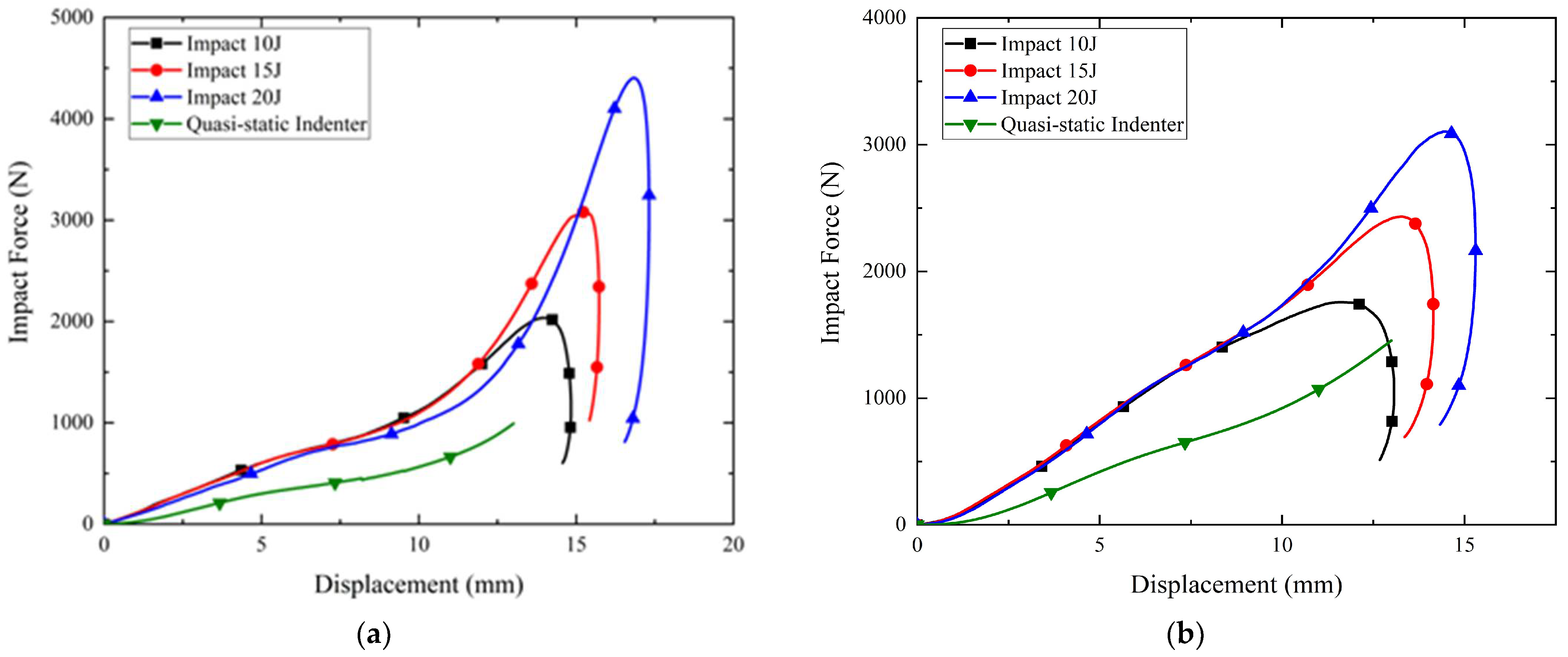
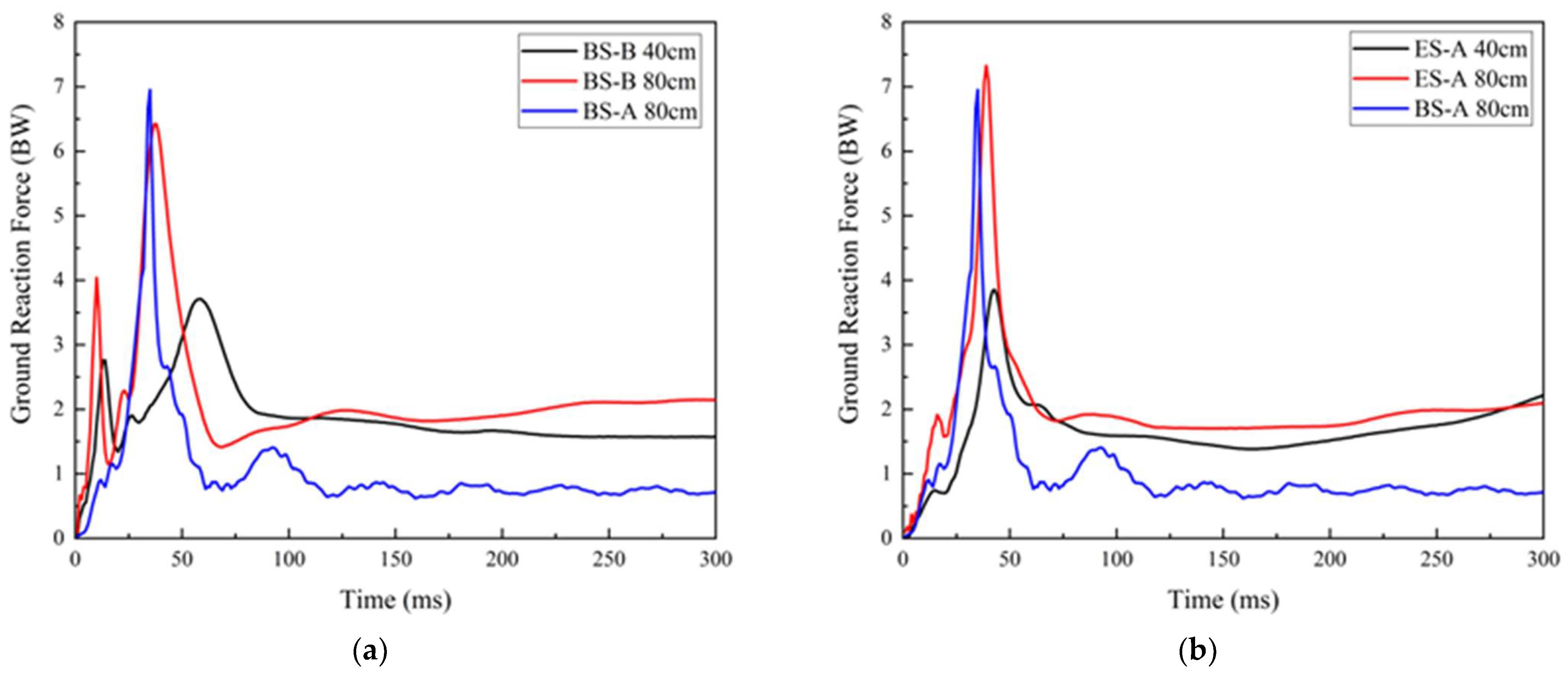
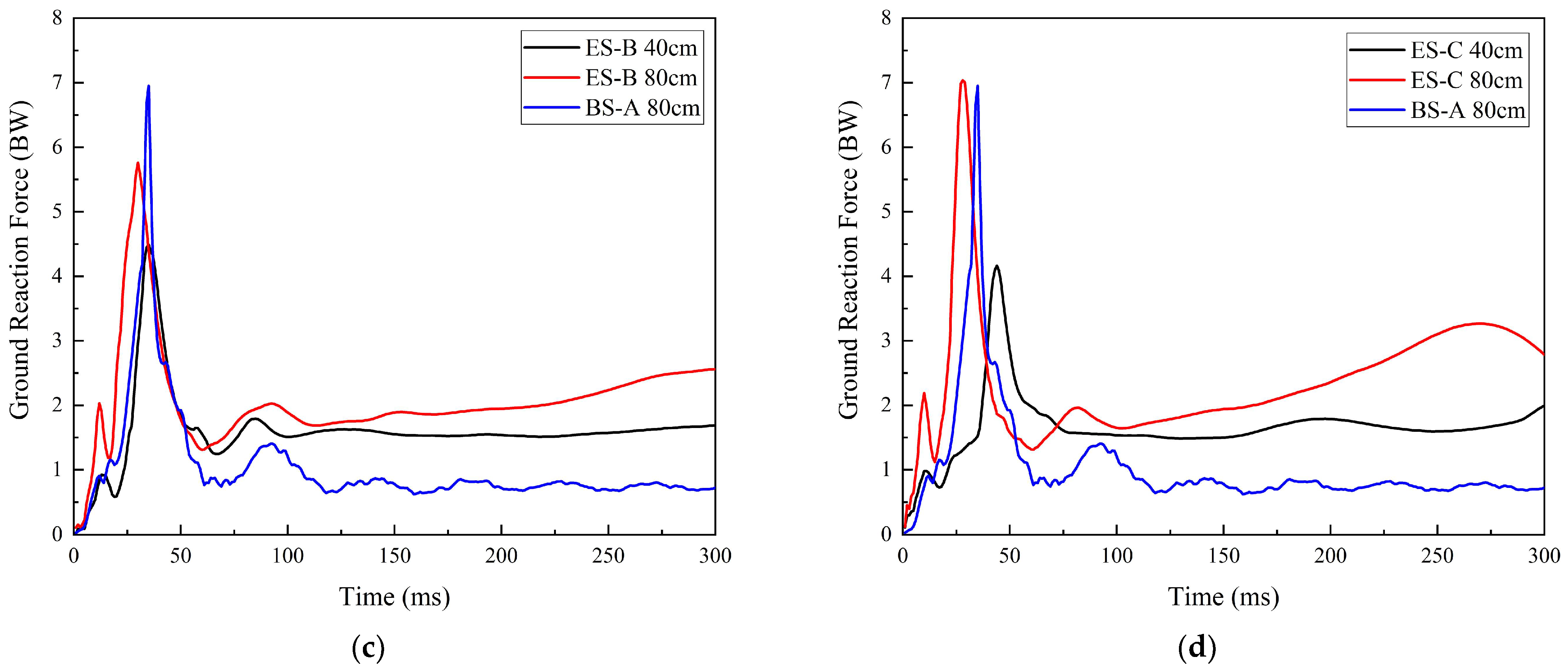

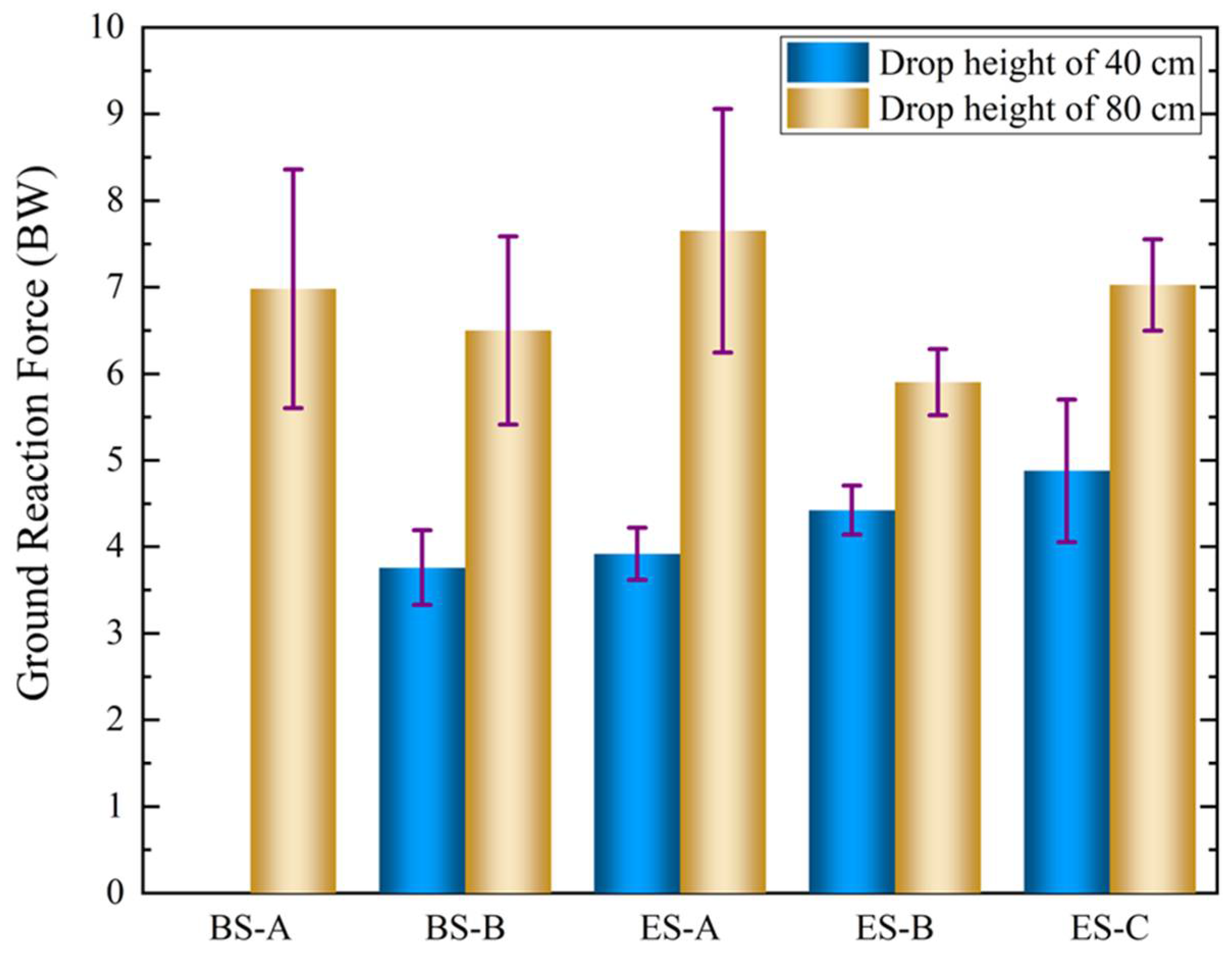
| Sole Types | Peak GRF at 40 CM (BW) | Peak GRF at 80 CM (BW) | |||
|---|---|---|---|---|---|
| Mean | Standard Deviation | Mean | Standard Deviation | Improvement Relative to BS-A | |
| BS-A | 6.98 | 1.38 | 0 | ||
| BS-B | 3.76 | 0.43 | 6.50 | 1.09 | 6.9% |
| ES-A | 3.92 | 0.3 | 7.65 | 1.41 | −9.6% |
| ES-B | 4.88 | 0.28 | 5.90 | 0.38 | 15.5% |
| ES-C | 4.42 | 0.82 | 7.02 | 0.53 | 6.5% |
| Landing Technique | Shoe Type | Subject Body Weight (KG) | Drop Height (CM) | Peak GRF (BW) | Ref. |
|---|---|---|---|---|---|
| PLF | Military boots | 63.2 (5.4) | 54 | 6.2 (1.0) | [4] |
| PLF | Regulation Army boots | No report | 93 | 9.34 | [47] |
| 137 | 14.07 | ||||
| HSPL | Barefoot | 57.8 (8.5) | 32 | 16.95 (2.59) | [48] |
| 52 | 18.88 (3.46) | ||||
| 72 | 23.98 (4.21) | ||||
| HSPL | ES-B | 65 (5.2) | 80 | 5.9 (0.38) | Present work |
| BS-A | 6.98 (1.38) |
Publisher’s Note: MDPI stays neutral with regard to jurisdictional claims in published maps and institutional affiliations. |
© 2022 by the authors. Licensee MDPI, Basel, Switzerland. This article is an open access article distributed under the terms and conditions of the Creative Commons Attribution (CC BY) license (https://creativecommons.org/licenses/by/4.0/).
Share and Cite
Xiao, Y.; Hu, D.; Zhang, Z.; Pei, B.; Wu, X.; Lin, P. A 3D-Printed Sole Design Bioinspired by Cat Paw Pad and Triply Periodic Minimal Surface for Improving Paratrooper Landing Protection. Polymers 2022, 14, 3270. https://doi.org/10.3390/polym14163270
Xiao Y, Hu D, Zhang Z, Pei B, Wu X, Lin P. A 3D-Printed Sole Design Bioinspired by Cat Paw Pad and Triply Periodic Minimal Surface for Improving Paratrooper Landing Protection. Polymers. 2022; 14(16):3270. https://doi.org/10.3390/polym14163270
Chicago/Turabian StyleXiao, Yilin, Dayong Hu, Zhiqiang Zhang, Baoqing Pei, Xueqing Wu, and Peng Lin. 2022. "A 3D-Printed Sole Design Bioinspired by Cat Paw Pad and Triply Periodic Minimal Surface for Improving Paratrooper Landing Protection" Polymers 14, no. 16: 3270. https://doi.org/10.3390/polym14163270
APA StyleXiao, Y., Hu, D., Zhang, Z., Pei, B., Wu, X., & Lin, P. (2022). A 3D-Printed Sole Design Bioinspired by Cat Paw Pad and Triply Periodic Minimal Surface for Improving Paratrooper Landing Protection. Polymers, 14(16), 3270. https://doi.org/10.3390/polym14163270







